Ahead of the publication of Shaun Tan’s The Singing Bones, a mesmerizing art book revealing Grimms’ Fairy Tales in sculptural form, we asked the world-renowned artist about his project and the arts at large.
Tell us about your sculptures. Why did you decide to re-create Grimm’s Fairy Tales in visual form?
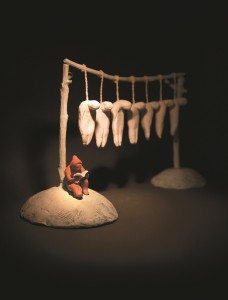 For a start, I don’t think you can recreate Grimm’s Fairy Tales in visual form – they are just so unique and strange – a bit like trying to tell someone about a fascinating dream you just had, and watching their eyes glaze over with boredom as you enter the details. Some things just don’t translate. But as an illustrator I believe you can often add visual images as a complimentary element to text, not so much ‘illustration’, but a kind of side dish, and many artists have illustrated fairy tales accordingly for centuries. In practical terms, I was originally asked to embellish a volume by a German publisher, a number of Grimm’s Tales that had been excellently rewritten by Philip Pullman. I basically got carried away and asked if I could produce 50 images, and then after that project expanded it to 75, to include some tales I found intriguing but which were not part of Philip’s original selection. These have been collected for the first time in The Singing Bones, as they were otherwise not available for English readers. Notably I decided not to included the full fairy tales, but instead have selected very limited excerpts, a handful of sentences, with the intention of giving the reader space to imagine a story around each image in their own way, so it became a kind of imaginary museum catalogue.
For a start, I don’t think you can recreate Grimm’s Fairy Tales in visual form – they are just so unique and strange – a bit like trying to tell someone about a fascinating dream you just had, and watching their eyes glaze over with boredom as you enter the details. Some things just don’t translate. But as an illustrator I believe you can often add visual images as a complimentary element to text, not so much ‘illustration’, but a kind of side dish, and many artists have illustrated fairy tales accordingly for centuries. In practical terms, I was originally asked to embellish a volume by a German publisher, a number of Grimm’s Tales that had been excellently rewritten by Philip Pullman. I basically got carried away and asked if I could produce 50 images, and then after that project expanded it to 75, to include some tales I found intriguing but which were not part of Philip’s original selection. These have been collected for the first time in The Singing Bones, as they were otherwise not available for English readers. Notably I decided not to included the full fairy tales, but instead have selected very limited excerpts, a handful of sentences, with the intention of giving the reader space to imagine a story around each image in their own way, so it became a kind of imaginary museum catalogue.
Do you think there is a crossover between literature and visual art?
Yes and no. Of course with any creative activity there is crossover: I think the forms of art are dictated more by cultural conventions, eg. printing presses, education or art patronage, than any inherent categorisation. I often think about the oldest examples of cave art, showing long sequences of images of animals moving. Are they art or literature? The creators were, I’ll bet, too busy trying to convey a lived experience to worry about academic definitions. The work of children is also instructive, the way they wrangle pictures and words interchangeably. We are all just trying to figure out the transition from something inside the mind to something outside of it; how does one do it? As a writer and artist myself, I’m constantly switching hats according to what seems to work best in a given situation, words or pictures.
When it comes to illustrated literature, I actually think there is more tension than confluence. In many cases the pictures mismatch the images conjured by words, or the words risk constraining the meaning of an image. But that very tension is something that attracts me, the fact that there can be a little discord. In many of my picture books I try to take advantage of that, so that images can even contradict stories, or subvert what is being authoritatively stated, or draw attention to a minor character or place. The last thing I try to do with an illustration is to describe something that the text is already servicing very well.
How have you (re-)interpreted Gimm’s Fairy Tales?
The impulse is often to move towards clarity and detail: what does the princess look like? What is the expression on the frog’s face? How does the witch grasp at the children exactly? Instead, I’ve tried to maintain the generalities and lack of specific characterisation that I found in Grimm’s fairy tales, the fact that the story is told quite summarily and almost worn down to bones by time. I was also inspired by folk art, especially old traditions such as Inuit soapstone caring, clay Pre-Columbian figurines, and Oceanic art; these have always fascinated me, ever since I was a small child. That style of representation seemed a perfect compliment to Grimm’s tales, at once nuanced and simplified, and polished by multiple ‘retellings’, and somehow universal even though culturally specific. I thought it was also interesting to illustrate fairy tales with objects rather than images, although such objects could become images through photography. It maintained a certain earthiness or elemental quality that I sense in each tale.
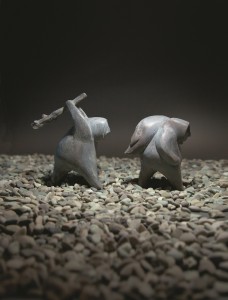 With the advent of technology and decline of printed matter, how would you encourage the younger generation to continue or develop an interest in reading? Can art be a conduit to this?
With the advent of technology and decline of printed matter, how would you encourage the younger generation to continue or develop an interest in reading? Can art be a conduit to this?
I think the broader question is about virtual and real things. I don’t think one is better than the other necessarily, and you could even argue that all art and literature is virtual, whether printed, painted or projected. You could even argue that technology improves literacy in many respects, not least for those with disabilities. I don’t see the choice of medium as a significant issue.
But one problem of technology I’ve noticed particularly as an illustrator is a tendency to shortcut attention, both with creativity and engagement, to speed up and thin out. I’m somewhat glad that I grew up in an environment where access to digital imagery was limited and I was forced to learn to draw using traditional materials, it meant that I paid a lot more attention to texture, light, mass and all other elements that are far more conveniently simulated using the excellent software available these days, but can leave you feeling visually short-changed. I guess my sculptures for this book also might serve as a reminder to some younger readers that physical object-making can offer a deeper experience than digital object making. My sculptures and intentionally quite textural, and improvisational, often using sticks and rocks from my backyard or other materials collected during walks in the real world. That said, I used Photoshop a little to develop many images, but you are still looking at real objects made from resistant materials, and I think that is always a big part of the magic of art-making. While I love digital tools, I much prefer that the basic material of my images is cut from the same fabric as the world it tries to represent.
“Life imitates art far more than art imitates Life.” Do you agree?
Maybe, only because I don’t think art is about imitating life… it’s a bit like saying that drawing is about grinding pencils into stubs. That is, imitation is a big device of art, but not any useful objective. I think art has more to do with about creating a parallel universe, a separate reality that kind of floats about this one in a non-imitative way, a more thoughtful way, but reveals many truths by doing so. Picasso’s famous line about art being the lie that tells the truth comes to mind here: ‘lying’ is a form of imitation, but it’s also doing something else, it’s suggesting an alternative reality.
But does life imitate art? If you expand the definition of art to things that are imagined, well then yes, certainly. You have to imagine things before you can do them. It’s hard to think of an exception to this rule. You could say that all of life is a creative act, or an artistic act, because of the role of imagination is motivating us to do things, finding a pathway forward.
How would you advise an emerging artist – in any medium – to forge a career in this increasingly over-commercialised world?
Well, it’s always been pretty over-commercialised, though it does seem to have gotten worse, such as in the area of film-making where original ideas are often less important than profit; or in the art market, where paintings can be reduced to little more than large canvas cheques. But at the end of the day, people are people, and people like good art. I think it’s important to look within yourself and think hard about what you like about writing, painting or drawing, and not be too mislead by things that are fashionable, cool, profitable, or intellectually valued. That can be tough, because one also wants to be commercially successful in some way, as there is nothing very romantic about starving. The trick is striking some sort of balance. I often recommend to young artists that they divide their work into two streams as I did early on, a commercial side open to compromise, and a private practice that has nothing to do with turning a profit, a place where you can experiment and play freely. In other words, not putting all your creative eggs in one basket, and also being very open-minded and adaptable.
Can you tell us about The Shaun Tan Award for Young Artists?
It was an award set up over ten years ago by a local public library in Western Australia, near where I was living and working, and from which it still operates. Every year student-age artists (about 5 to 17) are invited to send paintings and drawings for selection in an exhibition. Modest prizes are also given, with the disclaimer that it’s not really a competition or contest, because I don’t feel such things are relevant when it comes to free-wheeling creativity. It’s scale remains modest, even though it has grown over the years. The idea for it comes partly from the fact that as a child myself I received a lot of encouragement from similar awards – and importantly they were places you could send your work to. But also trying to present a little balance against the assumption that being an artist is not a ‘real job’, so each year I try to give a short talk to award recipients (and their parents) to the effect that art is a profession like any other, requiring the same degrees of seriousness, study and work. Hopefully it might be enough to nudge one or two budding artists over the line, because it’s not always easy to make that transition from art class to art practice, and young people need all the encouragement they can get.
The Singing Bones by Shaun Tan is published on 1st September by Walker Books.

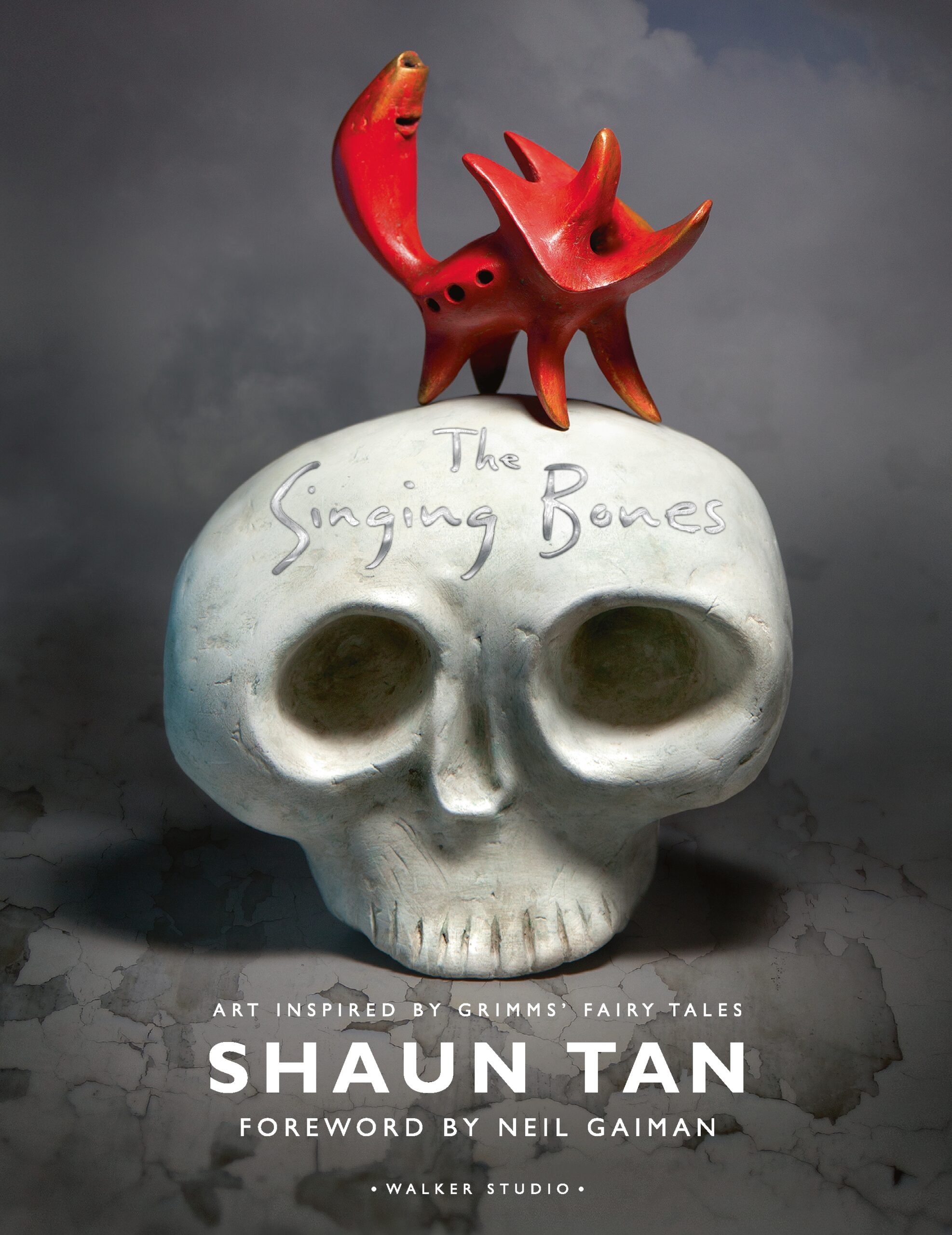
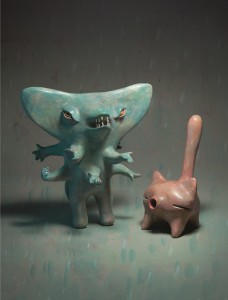
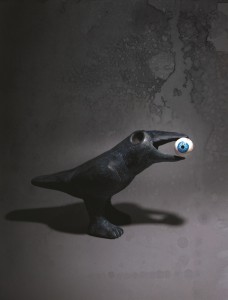
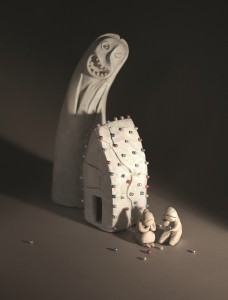
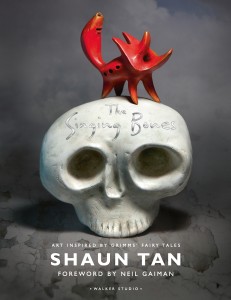

 Saving...
Saving...
2 Comments
Add Yours[…] Shaun Tan is a freelance illustrator from Perth, Australia, who had written and illustrated the acclaimed books: ‘The Rabbits’, ‘Tales from Outer Suburbia’ and the award winning graphic novel ‘The Arrival’. He has also directed an animated short of his book ‘The Lost Thing’ which won an Oscar in 2011. Tan’s illustrated books “… deal with social, political and historical subjects through surreal, dream-like imagery.” {1} To create this art work he uses a variety of mediums, these include: “… inks, charcoal, photocopies, pens, acrylics and linocuts.” His work isn’t exclusively two-dimentional. In his book ‘The Singing Bones’, Tan has created seventy-five three-dimentional pieces from clay to accompay some of Grimm’s Fairy Tales such as ‘Rapunzel’ and ‘The Frog King’. For this project his inspiration lay in “… folk art, especially old traditions such as Inuit soapstone caring, clay Pre-Columbian figurines, and Oceanic art…” which have fascinated him since he was a child. {2} […]
[…] Tan’s illustrated books “… deal with social, political and historical subjects through surreal, dream-like imagery.” {1} To create this art work he uses a variety of mediums, these include: “… inks, charcoal, photocopies, pens, acrylics and linocuts.” His work isn’t exclusively two-dimentional. In his book ‘The Singing Bones’, Tan has created seventy-five three-dimentional pieces from clay to accompay some of Grimm’s Fairy Tales such as ‘Rapunzel’ and ‘The Frog King’. For this project his inspiration lay in “… folk art, especially old traditions such as Inuit soapstone caring, clay Pre-Columbian figurines, and Oceanic art…” which have fascinated him since he was a child. {2} […]